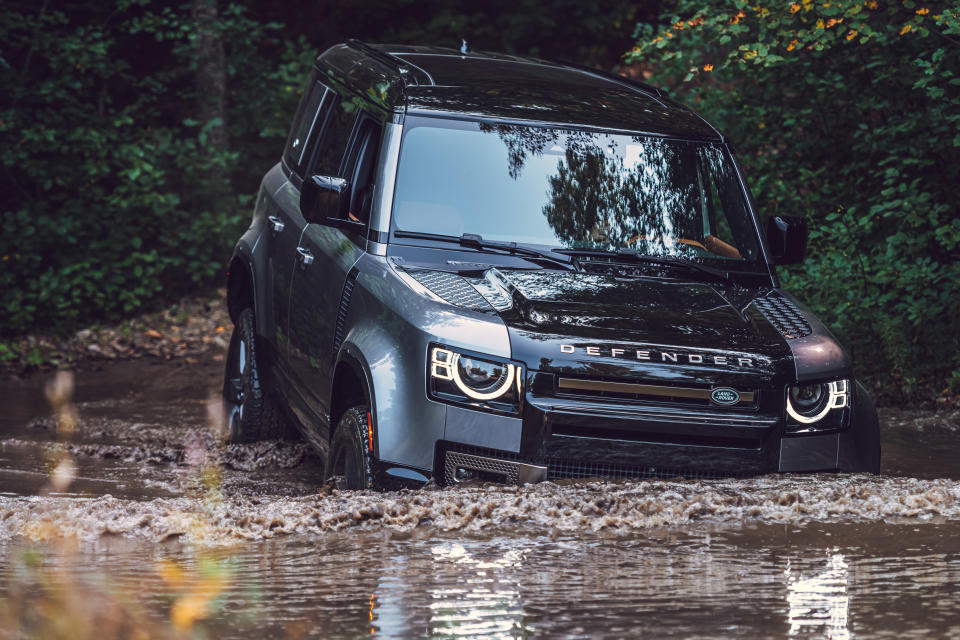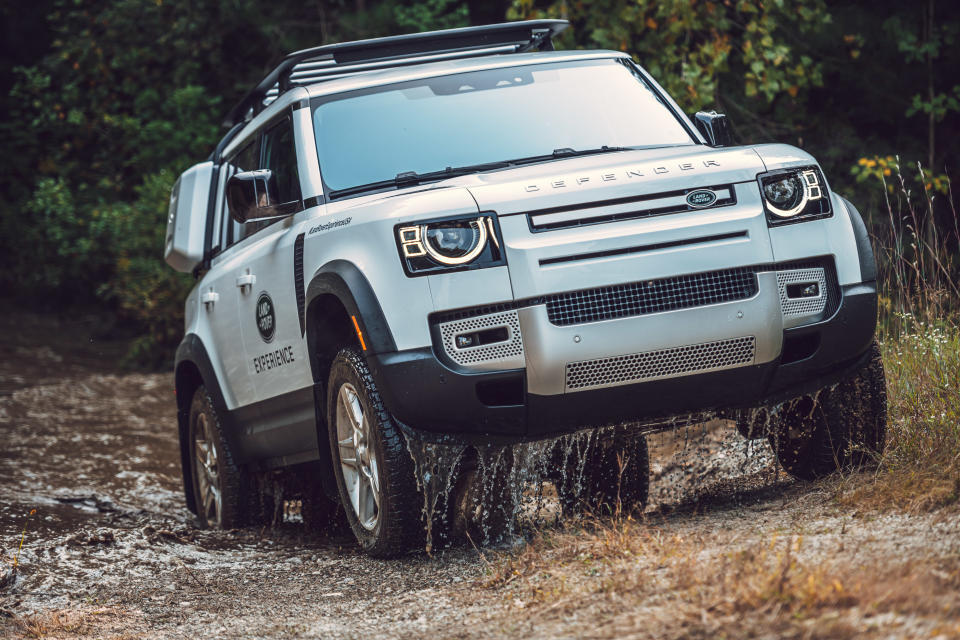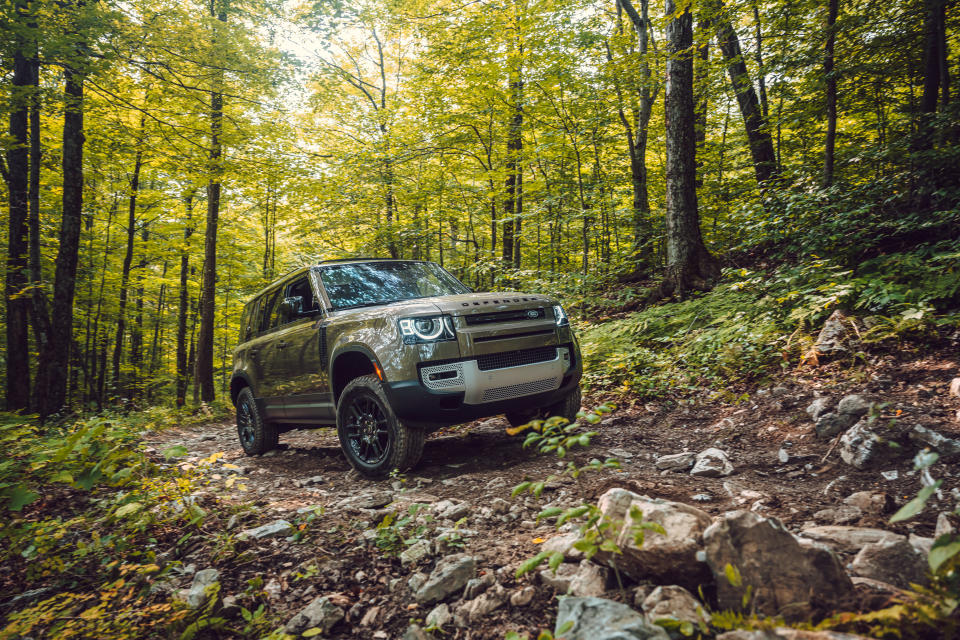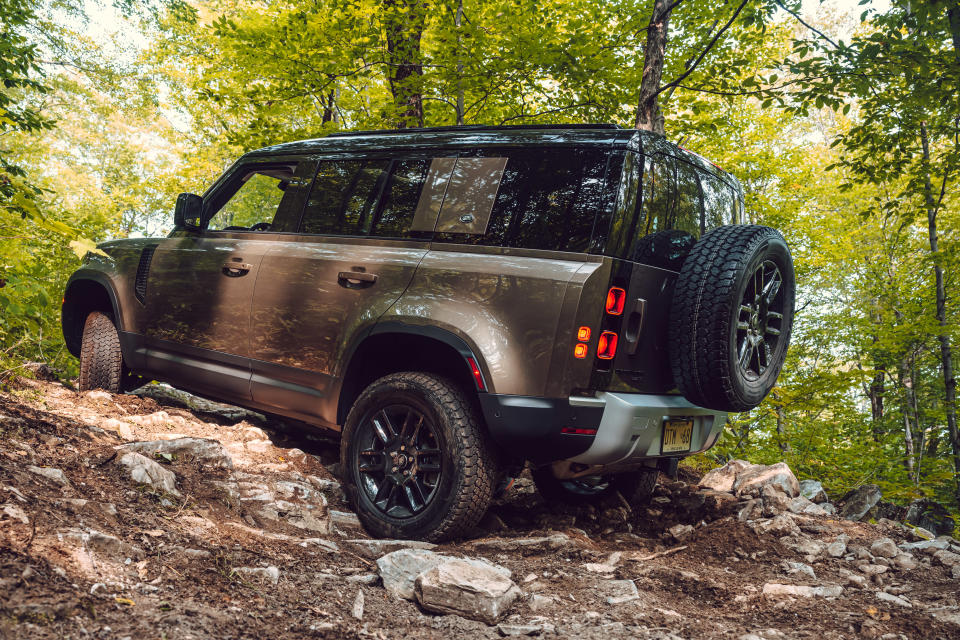2020 Land Rover Defender goes off-road, and upmarket
It’s no secret that hard-core Land Rover fans have been clamoring for the Defender’s return for years. So when it was announced the Defender would return following a 22-year absence in the U.S., needless to say the anticipation and hype in the car world was off the charts.
The all-new for 2020 Defender looked good in pictures, with an updated appearance that still embraced many of the elements of what makes a Defender, a Defender. Even a heritage look on the two-door ‘90’ model, complete with a white roof and ‘steelie’ wheels, is on offer.
I’m one of those old-school Defender fans, and I finally had the chance to drive the new one - both on-road and off - over the course of a test weekend. But it’s not exactly priced like the utilitarian, jack-of-all-trades Defender of old. It’s gone upscale.
The new Defender — form follows function

Before we get into the looks, let’s start on what the Defender represents. Land Rover says the Defender reflects what they call overarching brand characteristics like ‘Design,’ ‘Capability,’ and ‘Durability.’ These are the traits designers and engineers were focusing on when creating the all-new Defender.
The Defender’s design really echoes the other traits Land Rover is touting — capability and durability — which you can see from a cursory standpoint when you look inside and out. Refinement on the other hand, another Land Rover trait, is saved for the higher-end Range Rover.
In person the first thing you notice is that the Defender has a high stance, and there’s not much in terms of chassis or suspension components sticking out underneath. The tidy packaging below, and short overhangs both front and rear, give the Defender a 30-degree approach angle (and 40-degree departure), as well as the ability to traverse 45-degree gradients, and an impressive 35-inch water wading depth. These figures are the same for both the Defender 110 (4-door) and 90 (2-door).
I was surprised to hear the Defender is not a body-on-frame SUV (which many hard-core off-roaders are), but rather a unibody, or monocoque chassis construction that’s all-aluminum. This gives the car more stiffness, tighter sheet metal, and generally speaking better safety and crash-test figures.
Capability is the name of the game

While the design offers the Defender some notable advantages (approach angles, wading depth, etc.), much of the Defender’s capability comes from what’s inside.
The Defender is available in the U.S. with two engines. The base engine offered on the standard Defender and Defender S models is a turbocharged inline 4-cylinder, outputting 296hp and 295 lb-ft of torque. The uprated engine, available on the higher Defender trims (SE, HSE, X, and First Edition), pumps out a healthy 395 hp and 406 lb-ft of torque. This allows the Defender to tow an impressive 8,200 lbs.
But what’s most impressive is what allows that power to go to wheels: the transmission and all-wheel drive system. And that’s where the test drive comes in.
The on- (and off-) road test

Land Rover offered up individual, socially distanced drives for journalists this fall to test out the Defender. I picked up my Defender (a fully-loaded Defender X model) from JLR headquarters in New Jersey, and headed for the Land Rover Experience Center in Manchester, Vermont, where we’d take the Defender off-road.
My Defender X was tricked out with dark grey wheels, black contrast roof, black hood, smoked taillights, and some big off-road features like configurable terrain response, which I’ll get into.
I’ve already detailed my impression of the exterior, but the interior is notable as well. Land Rover really emphasized the durability and design elements here; the Defender interior is unlike any other Land Rover.

In it you’ll discover a very clean, and sparse dashboard. This is set off by two digital displays, one under the instrument panel, and the other in the center stack. For the most part that’s pretty much it. Yes, it’s pretty sparse in there, but that’s the vibe Land Rover is going for here — only the essentials.
The materials in the cabin are all made from a range of “durable interior upholsteries,” meaning materials that can be wiped down and take some abuse from those weekend adventures. Even the flooring is a heavy duty rubberized material that appears to be able to withstand some abuse.
Don’t get me wrong — it’s still a nice place to be, especially in Defender X trim here with open-pore walnut veneer, and comfortable seats wrapped in Windsor leather. But you’re not going to mistake the Defender for a Range Rover.

The shift knob is below the center-stack touchscreen, along with an ingenious set of two digital knobs, that handle everything from climate control, to seat heating and cooling, and even drive modes.
Without running boards or bars, it’s a bit of a step to get into the Defender, but once you’re aboard you have a clear, commanding view through the big windshield.
Initial acceleration is decent for an SUV, but even with the uprated turbocharged 6-cylinder you won’t blow the doors off the truck either. Shifting the gear selector into ‘sport’ mode does give you more aggressive shifts and acceleration. Steering is a little numb, and boosted a tad too much for my liking, but does make taking the Defender around town relatively painless.

With my Defender X running on air suspension, the ride was surprisingly smooth for such a capable off-roader, and with those comfortable seats and high-seating position, I easily gobbled up those highway miles en-route to Manchester.
And this is what is most important for those 90% of buyers: yes they like the capability, but what they really care about is if they can run errands and commute to work and not feel like they’re driving a tractor with 33-inch tires on it. Also good for the suburban set, the Defender has available three-row 7-passenger seating, or even a two-row 6-passenger setup if you option the ingenious middle front-row seat that doubles as a console when not in use.
After a three-hour, mostly highway drive, we arrived at the experience center, where the fun really began.

Land Rover knew at its core, the Defender had to be a capable, off-road beast. So they threw the kitchen sink at it. And that starts with the four-wheel drive system.
Now a configurable version of Land Rover’s Terrain Response system debuts in the new Defender (standard on X trims, and optional on others), which allows you to select modes to suit particular off-road conditions. On its face that doesn’t sound too fancy, many competitors have similar drive modes.
However, the Defender’s system is much more than just drive modes, and the off-road modes are completely adjustable. For example, in typical off-road vehicles, drivers can lock (or unlock) the differentials manually and use low gears to control power output and grip. In the Defender, drivers can prevent slipping by using the ‘CenterSlip Limited’ and ‘Center and Rear Slip Limited’ options on the touchscreen controller to manually dial in how much ‘slip’ you want in the differential. It is infinitely adjustable, and Land Rover says this is the world’s first application of this technology.

Now if that sounds like a lot, and you want to just focus on the drive ahead and not tweak things like differentials, Land Rover’s Terrain Response 2 system can do this all automatically, meaning the system will recognize the driving surface and configure the vehicle for optimal setup with no input from the driver. The system continuously, and variably unlocks and locks the differentials, and adjusts traction and power to get you through basically anything.
And to be clear we faced a bevy of obstacles and rough terrain at Land Rover’s off-road course. From deep ruts, uneven and muddy terrain, and hard-core boulders, the Defender came through even in tough spots that really surprised me.

The air suspension helped a lot, giving the Defender more clearance and the ability to really compress the corners deeply when needed. And while we were driving over slippery mud and rocks that were as smooth as porcelain, the tires gripped, and I could watch the differentials, depicted in the center screen, go from unlocked to fully locked and in between, as the system deemed necessary.
Truly remarkable stuff, and very cool technology. The Land Rover course instructors, who knew the terrain inside and out and guided us through the really tricky parts from outside the vehicle, continually pushed us to test the outer limits of the Defender. Steep inclines, steep declines, paths that had the Defender driving on a 45-degree angle lengthwise, we basically saw it all. And the Defender delivered, and then took us right off the off-road course and back onto Main Street without a complaint, or chassis rattle.
The bottom line

Yes, the Defender name is back and it’s packing some serious hardware. Land Rover made pains to make sure the truck delivered on its heritage of uber-capability, but also updated it for the modern age. The only drawback is one that isn’t a surprise, and that’s price.
The base, two-door Defender with the 4-cylinder turbocharged engine starts at $49,900. That’s with no options, not even the cool side-mounted gear carrier, or foldable step-ladder. You are definitely getting a lot of capability for the price, although in something of a Spartan-looking package. Start adding in higher trim levels and features like a bigger engine and the advanced terrain response system, and you cross the $80,000 price rubicon like the Defender X I tested.

It’s a lot of money, but the Defender name is legendary, and one that fans are willing to pay for to get into the latest and greatest version. Fans and knowledgeable buyers know what you’re getting: extreme capability and durability, all wrapped up in a pretty unique design. There’s nothing really in the segment quite like it.
So I may have some quibbles on pricing, but with older versions of the Defender commanding massive values in the used market, and buyers looking more and more at outdoor, socially-distanced activities, maybe the going rate for the all-new, adventurous Defender truly reflects what the market will bear.

——
Pras Subramanian is a reporter for Yahoo Finance. You can follow him on Twitter and on Instagram.
Related stories:
Porsche Cayenne S: can Cayenne owners have their cake and eat it too?
BMW X5 xDrive50i - a beastly SUV that’s also a tech marvel
'2 Dudes': Audi goes back to the future with the new Q8



